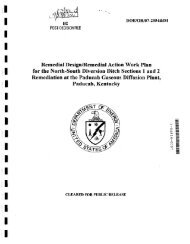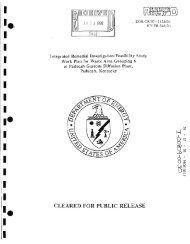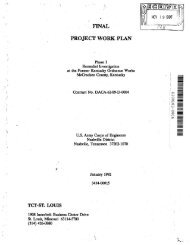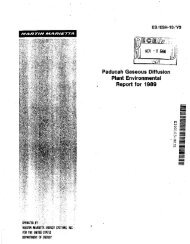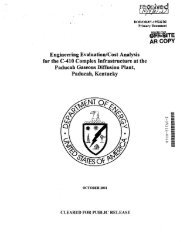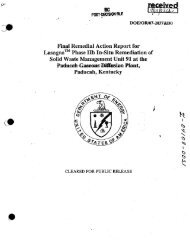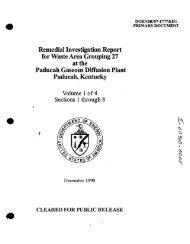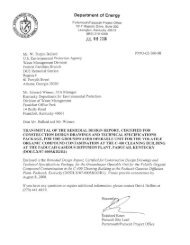1 - paducah environmental information center
1 - paducah environmental information center
1 - paducah environmental information center
You also want an ePaper? Increase the reach of your titles
YUMPU automatically turns print PDFs into web optimized ePapers that Google loves.
Paducah Site<br />
;<br />
,-<br />
materials released to the environment and<br />
human beings. In practice; only a few pathways<br />
constitute the major sources of exposure in any<br />
given _ situation,<br />
For the Phase I Remedial Action Site<br />
Investigation, CH2M Hill conducted a<br />
preliminary assessment of risk to the health of<br />
the public from contaminants at the Paducah Site<br />
(CH2M Hill 1990). This study identified four<br />
primary pathways that each could contribute<br />
greater than 1 % 'to 'the total off-site dose:<br />
groundwater ingestion, sediment ingestion,<br />
wildlife ingestion, and exposure to direct<br />
radiation. Since that preliminary assessment,<br />
groundwater wells that supplied drinking water<br />
in the downgradient direction from the PODP<br />
have been sealed to prevent use, resulting in a<br />
loss of that pathway. In addition, the Northwest<br />
Plume _ Oround\Vater System began operation in<br />
1995 resulting in an airborne pathway -now<br />
included in the dose calculations. -Furthermore,<br />
in 1999 a drinking water pathway was added for<br />
consumption of surface water at the nearest<br />
public drinking water source (Ohio River at<br />
Cairo; Dlinois).<br />
To fully _ assess the potential dose to the<br />
public, a hypothetical- group of extreme<br />
characteristics is used to postulate an upper limit<br />
to the dose of any real group. This is referred to<br />
as the worst-case scenario. Actual dose received<br />
is likely to be considerably less than the dose<br />
calculated for the worst-case scenario.<br />
Terminology and Internal Dose<br />
Factors<br />
Most consequences associated _ with<br />
radionuclides released to the environment are<br />
caused by interactions between human tissue<br />
and various types of radiation emitted by the<br />
radionuclides. These interactions -involve the<br />
transfer of energy from radiation to tissue,<br />
possibly resulting in tissue damage. Radiation<br />
may come from radionuclides outside the body<br />
(in or on <strong>environmental</strong> media or objects) or<br />
from radionuclides deposited inside -- the body<br />
(by inhalation, ingestion, and, in a few cases,<br />
absorption through the skin). Exposures to<br />
radiation from radionuclides outside the body<br />
are called external exposures; exposures to<br />
radiation from radionuclides inside the body are<br />
called internal exposures. This distinction is<br />
important because external exposure occurs<br />
only as long as a person is near the external<br />
radionuclide; simply leaving the area of the<br />
source will stop the exposure. Internal exposure<br />
continues as long as the radionuclide remains<br />
inside the body.<br />
A number of specialized units have been<br />
defmed for characterizing exposures to radiation<br />
as defined in Appendix A Because the damage<br />
associated with such exposures results primarily<br />
from the deposition of radiant energy in tissue,<br />
the units are defined in terms of the amount of<br />
incident radiant energy absorbed by tissue and<br />
of the biological consequences -of that absorbed<br />
energy. These units include the following:<br />
• Committed effective dose equivalent<br />
(CEDE)-the total internal dose<br />
(measured in mrem) received over a 50-<br />
year period resulting from -the intake of<br />
radionuclides in a I-year period. The<br />
CEDE is the product of the annual intake<br />
(pCi) and the dose conversion factor for<br />
each radionuclide(rmemlpCi).<br />
• Effective dose equivalent-includes<br />
the CEDE from internal deposition of<br />
radionuclides and the dose from<br />
penetrating radiation from sources<br />
external to the body. This is a riskequivalent<br />
value and can be used to<br />
estimate the health-effects risk to the<br />
exposed individual.<br />
• Total effective dose equivalentincludes<br />
the sum of the effective dose<br />
equivalent (for external exposures) and<br />
the CEDE (for internal exposures). For<br />
purposes of compliance, dose equivalent<br />
to the whole body may be used as the<br />
effective dose equivalent for external<br />
exposures.<br />
Dose



